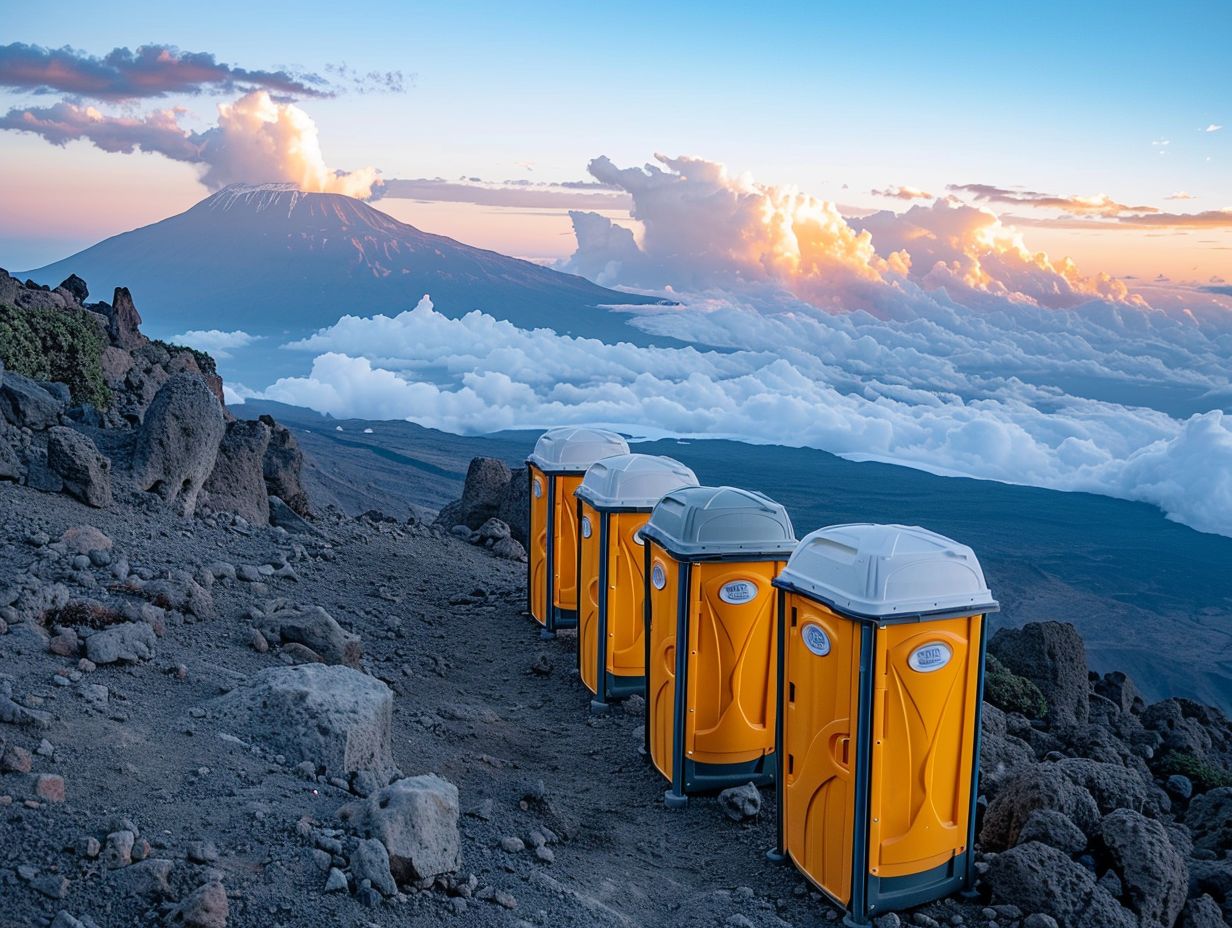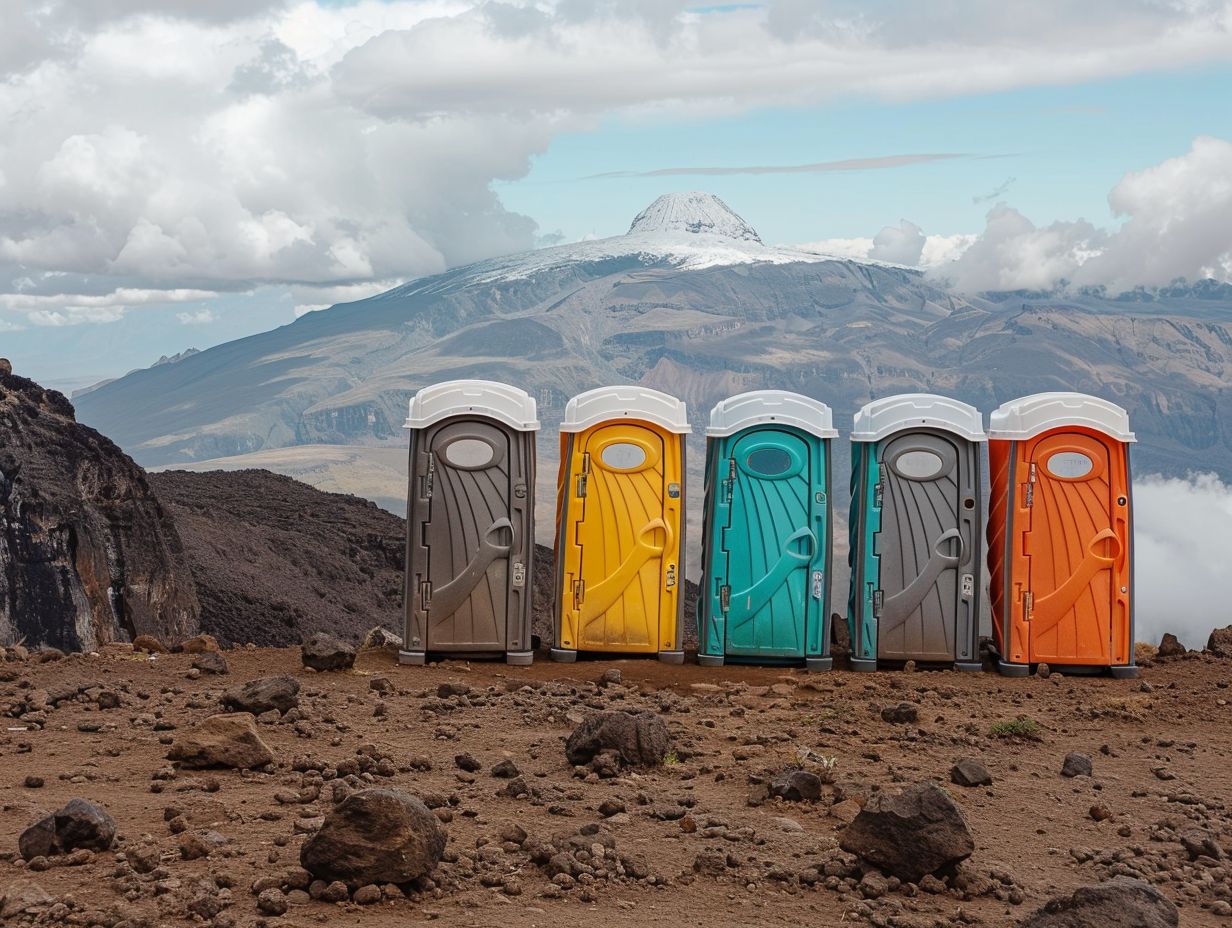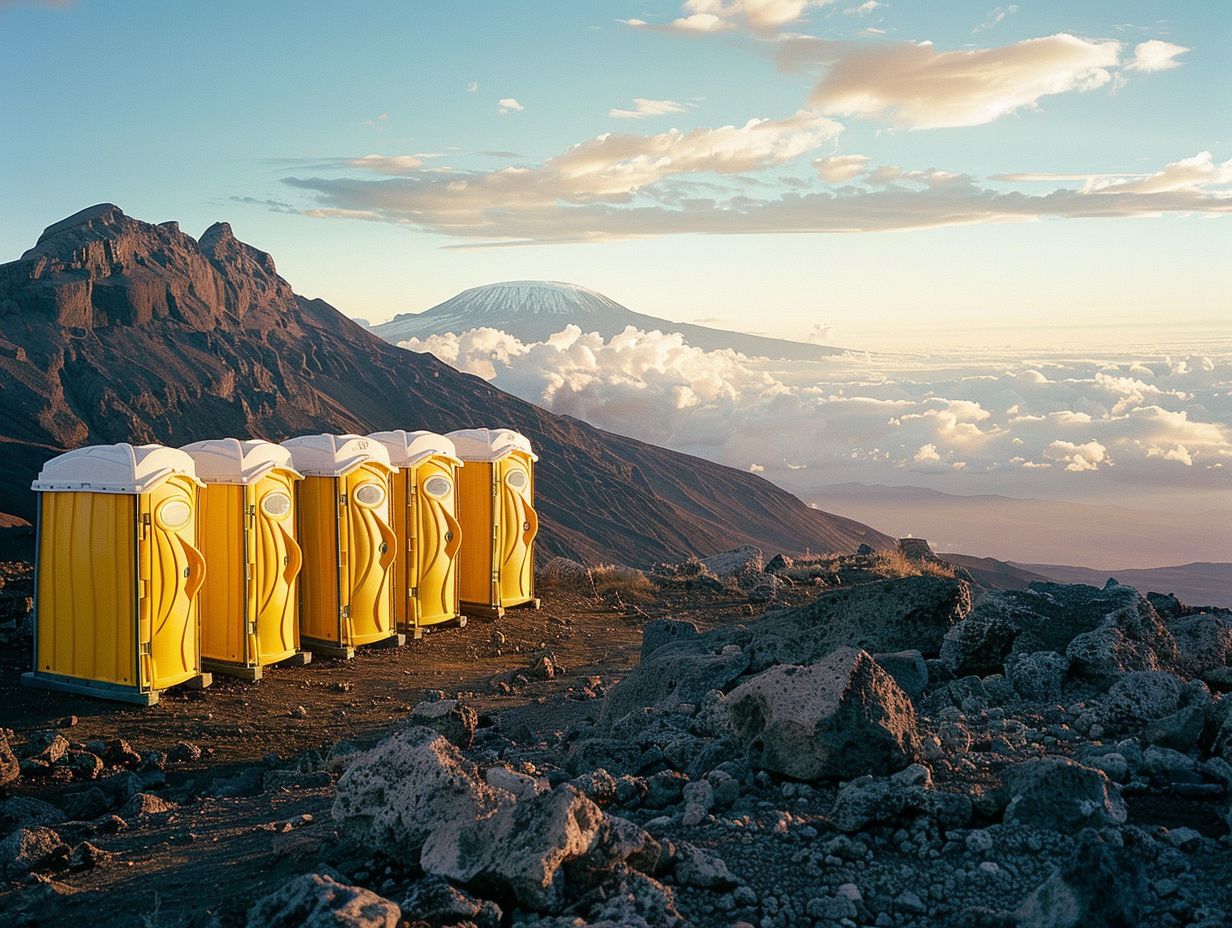
Toilets On Kilimanjaro
Proper sanitation is crucial for a successful and safe trek up Kilimanjaro.
We explore the different types of toilets available on the mountain, including pit toilets, portable toilets, and biodegradable bags.
Get tips on how to use and maintain these facilities, as well as what essentials to bring for toileting.
Learn how to handle emergencies like diarrhea, vomiting, and menstruation while on the mountain.
Stay tuned for valuable information on staying healthy and comfortable during your Kilimanjaro adventure!
Key Takeaways:

- Proper sanitation is crucial for climbers on Kilimanjaro to prevent health risks such as diarrhea and vomiting.
- There are three types of toilets available on Kilimanjaro: pit toilets, portable toilets, and biodegradable bags.
- Toilet users should properly dispose of waste, clean and sanitize the toilets, and take precautions for high altitude toileting.
The Importance of Proper Sanitation on Kilimanjaro:
Proper sanitation on Kilimanjaro is crucial for maintaining the pristine natural environment and ensuring the health and well-being of climbers and guides who embark on this challenging trek.
Mount Kilimanjaro, with its diverse ecosystem and fragile beauty, is not only a breathtaking adventure but also a delicate ecosystem that needs to be protected. By adhering to good waste disposal practices and maintaining personal hygiene, climbers play a crucial role in preserving the mountain’s cleanliness.
Improper sanitation not only tarnishes the mountain’s natural beauty but also poses serious health risks to climbers, such as contamination of water sources and the spread of diseases.
What are the Health Risks of Improper Sanitation?
Improper sanitation practices on Kilimanjaro can lead to serious health risks for climbers, guides, and the fragile ecosystem of the mountain.
Contamination of water sources is a major concern, as waste left untreated can seep into the ground and pollute the natural springs that supply water to both locals and climbers. When human waste is not disposed of properly, it can lead to the spread of illnesses like giardia and other waterborne diseases.
Littered items like plastic bottles and packaging not only mar the scenic beauty of the mountains but also pose threats to the local flora and fauna. Animals can ingest these items, causing harm to their digestive systems and overall well-being.
The Different Types of Toilets on Kilimanjaro:
There are various types of toilets available on Kilimanjaro, ranging from basic long drop toilets to more modern portable options provided by climbing companies and campsites.
While public toilet facilities are limited throughout the mountain, most trekkers rely on long drop toilets scattered along the trail, strategically placed for convenience.
- Many trekking companies equip their campsites with portable toilets to ensure a more comfortable experience for climbers.
- Porters play a crucial role in maintaining these facilities, ensuring they are clean and functional for the next group of climbers.
Disposable plastic bags are often used for waste disposal, emphasizing the importance of proper sanitation to prevent environmental contamination and ensure a safe trekking environment.
-
Pit Toilets:
Pit toilets, also known as long drop toilets, are common along the Kilimanjaro trek, providing essential sanitation facilities for climbers and porters amidst the rugged terrain.
These pit toilets are simple yet crucial structures designed to facilitate waste disposal in an environmentally friendly manner. They typically consist of a deep hole in the ground covered by a seat, offering users a place to relieve themselves. Despite their basic construction, pit toilets play a significant role in maintaining hygiene standards on the mountain, especially considering the lack of traditional plumbing systems in such remote locations.
Regular maintenance is essential to ensure these facilities remain sanitary and functional. Porters and guides tasked with trek upkeep often oversee cleaning and restocking toilet paper, striving to uphold hygienic conditions amid the challenging environmental conditions. The remote setting and high altitude pose challenges in waste management, accentuating the importance of responsible usage to prevent pollution and maintain a clean trekking experience.
-
Portable Toilets:
Portable toilets are a convenient and hygienic option for climbers on Kilimanjaro, especially in areas where traditional toilet facilities are not available or accessible.
These toilets are designed to be easily transportable, making them ideal for remote locations and high-altitude treks. Maintaining cleanliness is crucial for the health and well-being of climbers, and portable toilets help in upholding proper sanitation standards. Climbing companies and campsites go to great lengths to provide and manage these facilities efficiently to ensure a comfortable and safe trekking experience for all participants.
-
Biodegradable Bags:

Biodegradable bags offer a sustainable solution for waste disposal on Kilimanjaro, minimizing environmental impact and promoting responsible trekking practices.
These bags are designed to break down naturally over time, thus significantly reducing the amount of waste that accumulates on the mountain. By using biodegradable bags, climbers can actively contribute to preserving the ecological balance of the Kilimanjaro ecosystem. Not only do these bags help in minimizing littering, but they also play a crucial role in minimizing pollution and protecting the diverse flora and fauna of the region.
How to Use and Maintain Toilets on Kilimanjaro?
Proper usage and maintenance of toilets on Kilimanjaro are essential to ensure hygiene, minimize environmental impact, and promote a positive trekking experience for climbers.
When using the facilities on Kilimanjaro, climbers should adhere to the ‘Leave No Trace’ principles by following designated paths to the toilets.
- Properly dispose of toilet paper in designated bins or bags.
- Wet wipes should be packed out in a sealed plastic bag to prevent littering.
Maintaining personal hygiene is crucial; hand sanitizer should be used after each visit to prevent the spread of germs. Ensuring proper waste disposal practices and personal hygiene not only benefits the environment but also contributes to a more enjoyable trekking experience.
-
Proper Disposal of Waste:
Proper disposal of waste is a critical aspect of maintaining sanitation standards on Kilimanjaro, requiring climbers to adhere to responsible waste management practices throughout the trek.
When climbing Kilimanjaro, it’s crucial to follow guidelines on human waste disposal to prevent contamination of water sources and preserve the fragile ecosystem.
Carrying out non-biodegradable items like plastics, cans, and batteries is essential as they can take hundreds of years to degrade, causing long-term harm to the environment.
To minimize littering, climbers should pack out all trash, disposing of it properly at designated facilities to keep the mountain pristine for future generations to enjoy.
-
Cleaning and Sanitizing Toilets:
Regular cleaning and sanitization of toilets are essential tasks to uphold hygiene standards on Kilimanjaro, ensuring the health and comfort of climbers and guides during the trek.
Given the high altitude and harsh conditions on Kilimanjaro, maintaining clean and sanitized toilet facilities becomes even more crucial. Climbers play a vital role in this upkeep by carrying essential cleaning supplies such as biodegradable soap, toilet paper, and sanitizing wipes in their backpacks.
These items not only help climbers personally but also contribute to the overall cleanliness of the restroom areas. Proper waste disposal is equally significant to prevent environmental pollution, and climbers should adhere to designated waste disposal guidelines.
-
Tips for Using Toilets at High Altitudes:
When using toilets at high altitudes on Kilimanjaro, climbers should be mindful of the challenges posed by altitude sickness, limited facilities, and the need for efficient waste management strategies.
Altitude sickness can exacerbate dehydration, which can complicate waste disposal efforts. It’s crucial to stay well-hydrated to combat this.
Consider carrying portable toilet solutions like waste bags or biodegradable wipes for emergencies. Practicing Leave No Trace principles is essential; never leave waste exposed. Maintaining personal hygiene is equally vital – pack hand sanitizer, wet wipes, and a small shovel for burying solid waste. Adding these items to your gear checklist ensures a more comfortable and responsible climbing experience.
What to Bring for Toileting on Kilimanjaro?
Preparing the right toiletry items is essential for climbers undertaking the Kilimanjaro trek to ensure proper sanitation practices and hygiene standards are maintained throughout the journey.
Climbers should always carry essential supplies such as toilet paper to tackle nature’s call. Additionally, hand sanitizer plays a crucial role in preventing the spread of germs, especially in remote outdoor settings where access to water may be limited.
Personal waste bags are a must to pack out any solid waste responsibly and minimize one’s impact on the environment. Including these items in their gear list not only promotes cleanliness but also reflects a commitment to sustainable waste management practices on the mountain.
-
Toilet Paper:

Toilet paper is a vital item for climbers on Kilimanjaro to maintain personal hygiene and ensure proper waste disposal practices throughout the trek.
Given the remote and high-altitude nature of climbing Kilimanjaro, access to facilities along the trek is limited. This makes it crucial for climbers to carry their own supply of toilet paper.
Personal hygiene is not just essential for comfort but also plays a significant role in preventing infections and illnesses while on the mountain. Proper waste management is another critical aspect, as leaving used toilet paper on the trail can harm the local environment and affect the pristine beauty of the surroundings. It is highly recommended that climbers pack sufficient quantities of toilet paper in their gear list to last the entire journey.
-
Hand Sanitizer:
Hand sanitizer is a crucial hygiene product for climbers on Kilimanjaro, offering a convenient and effective way to maintain cleanliness and disinfection during the trek.
As climbers navigate the challenging terrains and altitudes on the majestic Kilimanjaro, they encounter various surfaces and shared facilities where germs can easily spread. With limited access to running water and soap, hand sanitizer becomes a lifesaver for quickly killing harmful bacteria and viruses that could otherwise lead to illnesses.
After using the toilet facilities along the route, sanitizing hands with hand sanitizer helps in preventing the transmission of germs, ensuring personal hygiene standards are upheld.
-
Personal Waste Bags:
Personal waste bags are essential for climbers on Kilimanjaro to contain and carry out their waste responsibly, ensuring minimal impact on the environment and maintaining sanitation standards.
These bags play a crucial role in proper waste management as they help in minimizing litter and pollution on the mountain. By using personal waste bags, climbers contribute to environmental protection by reducing the spread of waste across the landscape. These bags are essential for hygiene practices to prevent contamination of water sources.
When preparing for a climb, climbers should make sure to include sufficient quantities of personal waste bags in their gear lists. It is recommended to dispose of these bags properly, following the ‘pack it in, pack it out’ principle to preserve the cleanliness and natural beauty of Kilimanjaro. By adhering to responsible waste disposal methods, climbers can help maintain the pristine environment of this iconic mountain for future generations.
How to Handle Emergencies and Accidents on Kilimanjaro?
Being prepared to handle emergencies and accidents while on the Kilimanjaro trek is essential for climbers to ensure their safety, health, and well-being in challenging situations.
Common challenges such as diarrhea, vomiting, and menstruation issues can occur during the climb, requiring climbers to be ready for these situations.
Proper waste disposal and hygiene practices are crucial on the mountain to prevent contaminating water sources and spreading illnesses among climbers.
Carrying necessary medications and supplies, including rehydration salts, antiemetics, and menstrual hygiene products, is advisable. Responding promptly to unexpected emergencies, such as injuries or acute illnesses, by promptly seeking help from guides or other climbers can be lifesaving. Ensuring a clean campsite by tidying up and disposing of waste properly can contribute to a healthier environment for all trekkers.
-
Dealing with Diarrhea and Vomiting:
Diarrhea and vomiting are common health issues that climbers may face on Kilimanjaro, requiring prompt action, appropriate waste disposal, and hygiene precautions to prevent further complications.
When dealing with these symptoms, staying hydrated is crucial. Water intake should be increased to compensate for fluid loss. Recognizing signs of dehydration such as dry mouth, dark urine, or dizziness is essential.
Proper waste disposal, using designated areas or bags, is important to limit environmental impact. Maintaining good hygiene practices, such as regular hand washing and disinfecting surfaces, can help prevent the spread of pathogens. It’s advisable to seek assistance from knowledgeable guides or fellow climbers if symptoms worsen, ensuring safety and timely medical attention.
-
Managing Menstruation:
Managing menstruation during the Kilimanjaro trek requires climbers to implement proper waste disposal methods, personal hygiene practices, and carry essential supplies to ensure comfort and cleanliness.
One crucial consideration for female trekkers is the disposal of menstrual waste in an environmentally friendly manner. Opt for biodegradable sanitary products such as compostable pads or menstrual cups to reduce ecological impact. Always carry sealable bags to store used products until you reach designated waste disposal areas.
Maintaining personal hygiene is also vital; pack wet wipes and hand sanitizer for convenient clean-ups. Wearing moisture-wicking underwear and clothing can help prevent chafing and discomfort during long hikes on Kilimanjaro.
-
What to Do in Case of a Toilet Emergency:

In case of a toilet emergency on Kilimanjaro, climbers should remain calm, follow proper waste disposal procedures, prioritize personal hygiene, and seek assistance from guides or fellow trekkers to resolve the situation safely.
In challenging situations like this, it’s vital to act swiftly yet thoughtfully. Start by alerting your guide or the trekking team to ensure immediate support. Look for a private spot away from trails to handle the situation discreetly, always digging a small hole for waste disposal, at least 200 feet away from water sources.
Remember to pack necessary supplies like biodegradable toilet paper and hand sanitizer for maintaining hygiene standards. Respect the environment by leaving no trace behind, a principle followed by responsible climbers worldwide.
Frequently Asked Questions:
1. What are the toilet arrangements on Kilimanjaro?
A: On Kilimanjaro, there are designated toilet areas located at each campsite along the popular routes. These campsites have pit latrines or basic toilet facilities for climbers to use.
2. Are there public toilets available on Kilimanjaro?
A: No, there are no public toilets available on Kilimanjaro. The only toilets available are at the designated campsite areas along the popular routes.
3. Do I need to bring my own toilet paper on Kilimanjaro?
A: Yes, it is recommended to bring your own toilet paper as it may not always be provided at the designated toilet areas. Be prepared and pack some extra rolls in your day pack.
4. What is the proper etiquette for using the toilets on Kilimanjaro?
A: It is important to always use the designated toilet areas and not to leave any toilet paper or waste behind. Follow Leave No Trace principles and leave the area clean for others to use.
5. Are there any alternative options for toileting on Kilimanjaro?
A: Yes, some trekking companies offer portable toilets that can be rented for the duration of the climb. These are set up in private tents at the campsite and provide a more comfortable and hygienic option.
6. What should I do if I have to use the bathroom while trekking between campsites?
A: If you need to use the bathroom while trekking, it is important to go at least 70 meters away from the trail and any water sources. Dig a small hole and cover it up after use, and always practice Leave No Trace principles.